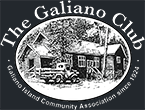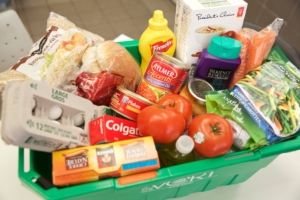by Allan Forget
In the early autumn of 1972 the Galiano Club sponsored a public ceremony at the Bluffs viewpoint to dedicate a commemorative stone monument to Max & Marion Enke, former island residents whose land donation, in 1948, started the creation of what is now known as ‘the Bluffs’. The inscription on the attached bronze plaque reads:
‘Erected September 1st, 1972, by the residents of Galiano Island in grateful memory of MAX ENKE and MARION ENKE 1884 -1971 1879 -1961 whose generosity made possible the establishment of Bluffs Park, thereby preserving in its natural beauty the land they loved, for all people, for all time.’
The monument project was spearheaded by Jean Lockwood, long-serving Galiano Club Secretary & President, assisted by Club Trustees, Roy Harding, Harold Dyer. Fred Robson & Pat Weaver had helped with the installation. The granite stone had been quarried locally, the bronze plaque created by the Ornamental Bronze Co. (Vancouver) at a cost of $163.46. Jean Lockwood had composed the inscription in consultation with the surviving Enke children, Dr. Stephen Enke (Washington, DC) & Mrs. Ruth Enke Chambers (Victoria, BC). Both Enke children, with other family members, attended the dedication ceremony.
Galiano Club President, Corinne Snell, led the ceremony. The Enke family members were introduced by Donald New who then gave a brief history of the property and “the efforts on the part of old time residents to make it into parkland”.
A refreshments table had been set-up nearby serving coffee, tea & desserts.
Mr. Max Enke arrived on Galiano Is. in 1907 a 23 yr old from Manchester, England not wanting to part of the family’s rabbit fur treatment business (located in Belguim), wishing instead to be a colonial farmer. His ship landed at the old Georgeson Bay wharf so Mr. Enke’s first view of Galiano would have been the open area between Mt Galiano and the Bluffs, the area now known as ‘the Valley’. Eventually Mr. Enke bought several large properties there, farmland & forest stretching from the Valley to the high Bluffs overlooking Active Pass. With the help of labourers brought over from Belgium, a successful animal farming operation was soon running well. Mr. Enke later married Marion Lejeune, another Manchester native, in a ceremony held in Quebec City with the couple eventually having two children, Ruth & Stephen. In addition to the Galiano farm, the family had a residence in Victoria, BC. Mr. Enke returned to Europe in 1929 to help with the family business in Belgium leaving his Galiano farm lands in the hands of a manager.
Before his departure however Mr. Enke had been approached by Mr. Donald New & other islanders with the idea of purchasing his acreage immediately above the Bluffs for the future use as a community park. This area had long been a popular hiking/picnicing destination for islanders & the idea of it becoming a park had long been discussed. Mr. Enke agreed to the idea and set a $1000 price on the 94 acres. The tough job of fundraising began by a sizeable group of islanders under the auspices of the Galiano Island Development Association (GIDA) soon began. One of the more popular fundraisers was a weekly gramophone concert held in the home of one of the Galiano Club founders, Mr. Paul Scoones.
Meanwhile, in Belguim, Mr. Enke had been arrested as an “enemy alien” by the invading German Army and placed in a Prisoner of War Camp where he would stay for the full duration of WW2. Not until 1947, after his return to Canada & to Galiano, would Mr. Enke & the fundraisers be able to once again connect. The $1000 had been successfully raised —- with the help of a good number of individual financial donations (known as the Original Donors) —- but the cost of the required land survey still needed to be tackled. Mr.Enke generously agreed to cover this new cost and also to donate an additional section of land which brought the total acreage being given to 139 hectares (342 acres). By this time the GIDA membership was no longer interested in becoming parkland owners so the title of what has come to be known as The Bluffs was offered to & accepted by, in 1948, the Galiano Club. A Deed of Trust was created in 1951 and the Club has owned and managed the parkland ever since. Mr. & Mrs. Enke eventually left the island deciding to reside full-time in Victoria. It was in that city that both died & are buried.
(More information about the acquisition & about the management of the The Bluffs can be found in the 2020 Management Plan displayed on the Galiano Club’s website.)

 Did you know that 1 in 3 food bank users in B.C. is a child, and 1 in 8 is a senior? That food banks help reduce hunger with dignity, and help reduce food waste too?
Did you know that 1 in 3 food bank users in B.C. is a child, and 1 in 8 is a senior? That food banks help reduce hunger with dignity, and help reduce food waste too?
 Volunteers Needed!!! There will be a work party on Saturday, October 26 to relocate the Shorepine trail in the Community Forest. We will also be doing some trail maintenance on that trail. Please join us if you can.
Volunteers Needed!!! There will be a work party on Saturday, October 26 to relocate the Shorepine trail in the Community Forest. We will also be doing some trail maintenance on that trail. Please join us if you can.